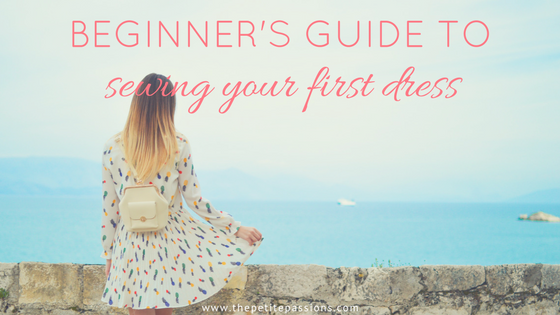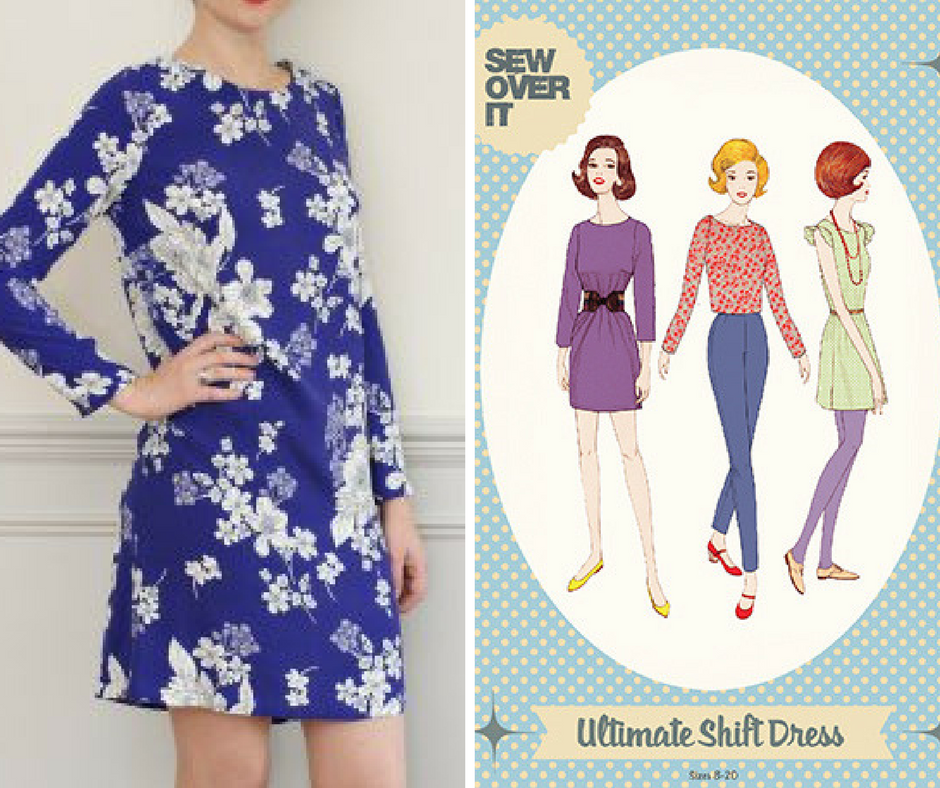'How do I make a dress?' ranks pretty high in sewing questions asked on Google because it's often the aspirational starting point for those taking up sewing and garment making. It can seem somewhat daunting at first but there are some simple choices that will help lead to a successful first project. Knowing what to pick appears obvious to most people, but it didn't to me as a beginner. I had literally no clue about what to pick for my fabrics and it's taken a while to understand what will really work. These are the main questions I had that made a difference and can help get you going quickly towards successful first dressmaking projects.
What do I need to be able to do?
You will need some basic skills and experience in operating a sewing machine. You do not need to be an expert, or very fast. You will need to be able to to sew using a straight stitch and be able to finish seams with a zig zag stitch at the very least. If you choose the right pattern you do not necessarily need to have made any garments before either.
If you have never used a sewing machine I would recommend getting going with an online class like Tilly and the Buttons' 'Make friends with a sewing machine' (review and lots of details here). This is by far the quickest means of getting going. You can also look around for in person classes near to you if you want to have a real life teacher guiding you through (review and more details of what this is like, again, here). There are also a lot of free to view videos on YouTube, but these aren't always as clear for complete beginners (depends on how you prefer learning I suppose!).
What do I need to buy?
Actually, very little in some cases. If you are lucky there might be a sewing cafe near you where you can go along and pay to use their equipment for a few hours. Otherwise you will need a machine, fabric scissors and pins. You do not necessarily need the most expensive machine to start with either (my first one was borrowed and cost less than £100). You will also be buying patterns, fabrics and thread.
If you want more details on what to get and where to get it from, then check out this Supplies Guide.
What pattern do I choose?
Big step number one. You need a pattern that matches your skill set, but also your personal style. It would be very nice if your first dress was one you were going to be able to wear a lot, rather than just for skill development. You will also need a pattern with very high quality instructions or tutorials. If you've chosen a popular pattern there will be a lot of pictures online that will give you an idea of what the finished item will look like. Lots of these will probably have been posted by bloggers who can then tell you what the pattern was like to follow too. My favourite place to search patterns is The Fold Line (see the badge in the sidebar). It is easy to browse through, and people leave their reviews alongside the patterns too.
Level
Patterns do tell you what level they are: 'Beginner' or 'Very Easy' is what to look for. I would go further than this though and have a good look at some of the construction elements that will be detailed with the pattern. Patterns with no fastenings or with elasticated waists are definitely easiest. Then zips, then buttonholes (in my view). Sleeves can also be attached in lots of different ways. Kimono or raglan sleeves are simplest (as well as no sleeves!).
Commercial or independent
There are two main types of sewing pattern: commercial and independent. Commercial companies are also known as 'the big 4' - Vogue, Simplicity (including Burda and New Look), McCall's and Butterick. These are widely available and usually cheaper.
This Simplicity pattern is a good starting point if you want to use a commercial pattern. It only has a couple of pattern pieces, but does need a zip and has darts too.
Independent pattern companies are basically everyone else! I personally prefer these patterns. I think their styles are more fashionable and they usually have a lot more help than commercial patterns. Some include colour photographs to show you what you should be doing. Others have blogs and sewalongs online which also include lots of detail as well as photos and videos too.
Personally I think there are two clear front runners when it comes to a first dress from an independent company: the Bettine dress and the Ultimate Shift Dress. Both of these dresses have some variations that you can include if you want as well as a wealth of additional support online through the pattern makers themselves.
The Bettine dress comes from Tilly and the Buttons. Tilly creates patterns especially for beginners so has lots and lots of help on her website. The booklet is full of lovely photographs too. This dress has no zips or buttons. The sleeves are also part of the dress and don't need to be attached separately. If you want to know more about what this dress is like to make, have a look at my review here.
The Ultimate Shift Dress comes from Sew Over It. Again, it doesn't have zips or buttons and has been designed with beginners in mind. You'll find lots of help on the website but even more on the Youtube Vlog. I highly recommend checking this out as there are tutorial videos and the weekly uploads can give you lots of ideas. One of the videos shows a lot of different versions of just this one pattern.
Paper or pdf
You'll often see options for independent patterns for paper or pdf versions. Pdfs are downloadable files that you can print off again and again, but you do need to cut and stick them together. For your first dress pattern spend a little more and get a paper version. It's going to save you one more complicated step. You'll also find the instruction booklets are much easier to follow too. Tilly's printed packs are very high quality, but by far and away the highest quality pattern I've had so far is from The Avid Seamstress. The Day Dress pattern is another great start for a first dress because every single element is explained very clearly, and the printed package is a tailored specifically for beginners. Find out more in this post, which tells you all about what is included, as well as my own thoughts making my evening version of the Day Dress.
What fabric should I buy?
This will make an enormous difference to how easy your dress is to sew as well as to how good it looks on in the end. You will get fabric suggestions with your pattern but they will be vague. For instance, it might say 'cotton' but I found it very difficult to pick the right cotton. Especially when you are buying online. If you can get to a fabric shop then you will be able to ask the staff for some help. Don't worry about it - they will love helping you. If you are making the Ultimate Shift dress, then Sew Over It's online fabric store will filter out all their most suitable fabrics for you - but they are not all the best for your first project!
What you will be looking for is a wearable fabric that is easy to sew. Steer clear of pretty sheer fabrics or knit fabrics- they are not your friend right now. They are too slippery and you need something a lot more reliable. (When you do get to using these fabrics for the first time find a detailed guide here for sewing with sheer fabrics successfully). Even rayons and viscose fabrics (which I do like a lot because they feel nice on) will be a little too slippery for now. You need something that is easy to cut and to sew.
Cotton is a good choice for a first project. It is easy to cut and to sew, and presses well too. There are also a lot of fun prints you can choose from. However, there are a lot of cottons out there and not all of them are comfortable. My first Francoise dress was made in a linen type cotton that is quite uncomfortable because it's fairly stiff and rubs, so never gets worn. I've since bought other cotton that is again too stiff! Cotton lawns are soft, but can also be see through, so exercise caution. Generally I would say that a darker Atelier Brunette cotton will do well. You can always splurge on a Liberty print (sometimes they have 50% off) but these too can be a little see through in paler colours.
Cotton chambray is an excellent choice for ease of sewing. It is a lightweight denim style of fabric and looks quite casual. It is very easy to sew with. Here is an example of a beginner skirt pattern made in chambray.
If you don't have a dress with darts, or that needs pressing, I definitely recommend using a crepe. Crepe fabrics are thicker and are opaque (usually). They don't always press very well but they usually sew well and always give quite a polished and professional look to dresses. (The black dress above is a crepe and it was quite simple to make).
So, those are the questions I needed answering when I made my first dress, and I hope that they can help you to get going with yours too. This could have been a much longer post but this really is the key information you need. Please do ask questions in the comments if you want a bit more detail. You can also check out my journey in the 'fabric' label on the side - this has all my makes from my very first class.

















No comments:
Post a Comment